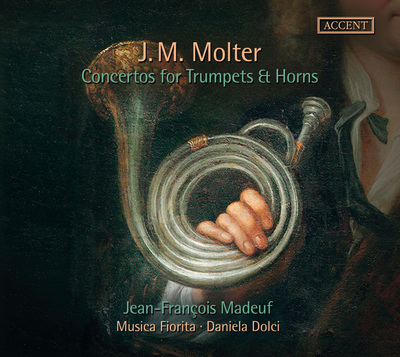 Jean-François Madeuf, J. M. Molter: Concertos for Trumpets and Horns (Accent ACC 24327).
Jean-François Madeuf, J. M. Molter: Concertos for Trumpets and Horns (Accent ACC 24327).
Johann Melchior Molter (1696–1765) was a highly regarded and prolific composer, born in Tiefenort near Eisenach. He spent considerable time in Italy and was influenced there
first by the music of Vivaldi, Albinoni, and Alessandro Scarlatti, and during a subsequent trip, the music of Pergolese and Sammartini. Recent scholarship in organizing Molter’s catalogue indicates that he had at his disposal not only ample string players, but also two players who could play oboe, flute, an/or chalumeau (the predecessor to the modern clarinet), three bassoons, two horns (probably doubling trumpet) two or three trumpets and timpani. This present CD is a collection of music which represents the variety of music which this ensemble could perform. There is the “Sonata grossa” in D for 3 natural trumpets, timpani, oboes, strings, and basso continuo as well as a Concerto in D for 2 natural trumpets, strings, and basso continuo. There is a concerto Pastoral in G for strings and basso continuo. There is a Sinfonia in D for strings and basso continuo with two additional horns. There are two very interesting pieces which feature the chalumeau: the Divertimento in F for alto chalumeau, tenor chalumeau, 2 horns, and bassoon and a work entitled “Tendrement” for alto chalumeau, bass chalumeau, and 2 horns in C basso with mute.
The performances offered on every one of these works is fresh and energetic while at the same time highly refined and elegant. There is unanimity in phrasing and over-all excellent ensemble playing. Praise is due to the performers of Music Fiorita as well as to the direction of Daniela Dolci. Particular attention should be given to the fine way that Henry Moderlak and Tomohiro Sugimara on natural trumpet, as well as Olivier Picon on natural horn match and blend in sound and refinement with Madeuf. This is all chamber music on the highest level.
Tucked away in the middle of this recording is a work which every trumpet player knows very well, Molter’s Concerto no. 1 in D for natural trumpet, strings, and basso continuo. It was regarded as an amazing feat when Armando Ghitalla recorded it in 1964. In the ensuing decades developments were made in the design of modern piccolo trumpets which helped this work become more feasible for more players. At the same time, though, great progress was made in the understanding of historical performance practices, in particular under the pioneering efforts and leadership of trumpeter Edward H. Tarr at the Schola Cantorum Basiliensis. More and more trumpet players began performing Baroque music using historical performance practices, most notably in playing trumpets without valves. The inherent out-of-tune aspects of some of the notes available to the natural harmonics of the trumpet posed seemingly unsolvable problems in performing much of the difficult literature. This led instrument makers to experiment and then add vent holes to these trumpets in order to solve this problem. This does not bring us any closer, however, to understanding and experiencing what this music would have sounded at the time it was written.
Jean François Madeuf has devoted his career to mastering the truly natural trumpet, one without vent holes. His recording of this present concerto by Molter represents a milestone in trumpet performance, as did his recording of Bach’s Second Brandenburg Concerto. Not only is he performing on a true natural trumpet, but he is playing a mouthpiece which is historically correct, and consequently much larger in size than current mouthpieces. Generally the modern player uses a smaller mouthpiece to achieve the high notes and delicate style demanded by this music. Madeuf is playing a copy of an original mouthpiece of the eighteenth century from a private owner in Basel (rim internal diameter is 19.5 mm). Graham Nicholson who made the copy thinks it is from Leichnmaschneider workshop (and we could see JFM playing the original one on photos of his internet site). His performance on this concerto by Molter is inspiring. There are numerous technical passages involving scales and thirds in which the eleventh, fourteenth, and sixteenth partials occur repeatedly; he handles them with great dexterity and very excellent intonation. Throughout all he blends perfectly with the strings in sound and refined phrasing.
This recording is a delight. It is a testament to the devotion to mastering historic performance practices. I recommend it highly.
-- James Miller



